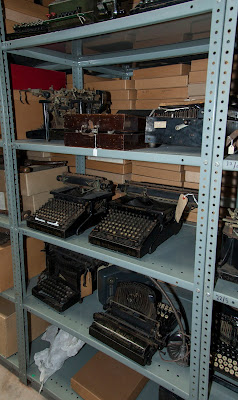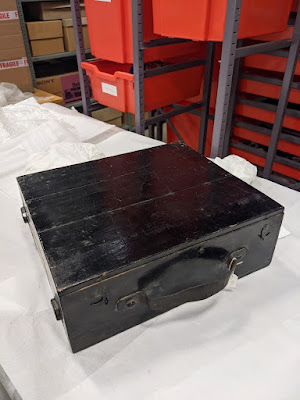We're very lucky to have lots of brilliant volunteers help us with our projects. In this special post, Kylie tells us about her recent experience as a conservation volunteer and explores one object she found especially interesting during her time with us.
This summer preparations began for the Wakefield Museums & Castles partial store move, which meant dusting and packing objects that are not currently on display at any of the museum locations. Together as volunteers, under supervision, we were able to help review shelves of objects so that their documentation would be up to date and their condition for moving would be improved.
Objects kept at the store will typically have significance
to Wakefield and the surrounding area. There were many interesting objects for us to
clean. For example, typewriters could have dust settle under the keys whilst on open shelves. Using brushes, microfibre cloths, smoke sponges, or museum vacuums, they
were returned to a clean state. These dry-cleaning methods will not always
cause drastic changes in appearance, but it is still satisfying to know objects
are cleaner and protected from damage by dust.
 |
| Some of the typewriters before we dry cleaned and repacked them. |
An object of particular interest was a black case of entomology equipment, used to study insects. The donor information named Walter Fletcher as the former owner, which is corroborated by the ‘WF’ scratched into a magnifying lens in the kit. Unfortunately, not much else is recorded about him, but it is clear he had a passion for entomology and took time to curate the required supplies over a long period of time.
 |
| Walter Fletcher's entomology kit |
Inside there were 44 small empty boxes, some made of metal but most were paper. The majority also had labels for tablets from chemists. The size of these must have been perfect for storing insects. Discerning the exact date of the supplies and owner is difficult, but the labels of the various pill boxes inside the case suggest it is from 1935-1968 due to the company name, Timothy Whites & Taylors. There are no objects made of plastic in the box, which may suggest earlier than the 1960s.
 |
| Pill boxes from local chemists seem to have been repurposed to store insect specimens. |
There were also wooden blocks with string wound around them that
would have been used to hold insects in place while drying them. There were metal
tools, scalpel blades and packages of pins to assist in this process. A large
net that could be dissembled was also able to fit in one compartment of the
case. Everything needed for this hobby or passion to be fulfilled.
There was care to detail in so much of what Fletcher kept.
He had nine glass slides with different insects, each carefully labelled.
In conserving this case, all objects were removed and the
interior cleaned by brushes and a museum vacuum. Some objects required wrapping
in acid free tissue, which will help stop any reactions between materials. This included the metal boxes because they react to relative humidity more than
other organic materials like paper. Objects that were loose, like two large
feathers, were also wrapped in tissue. Other objects were put into zip sealed plastic
bags. This included loose pins and other sharp hazards. The goal is that all the different parts of the kit would stay together if the case was moved and it would be unlikely for
damage to occur.
There are many more interesting objects to be found in the store.
Dry cleaning and improving packaging for storage is helpful so that the objects
will remain conserved for study or display in the future.
Special thanks to Kylie and all our conservation volunteers for their help preparing objects for the move. To keep up to date with this project and see what other treasures we discover, follow us on social media. Look out for updates on the hashtag #WFWhatsInStore.


No comments:
Post a Comment
We would love your comments - though they may take a day or two to appear.